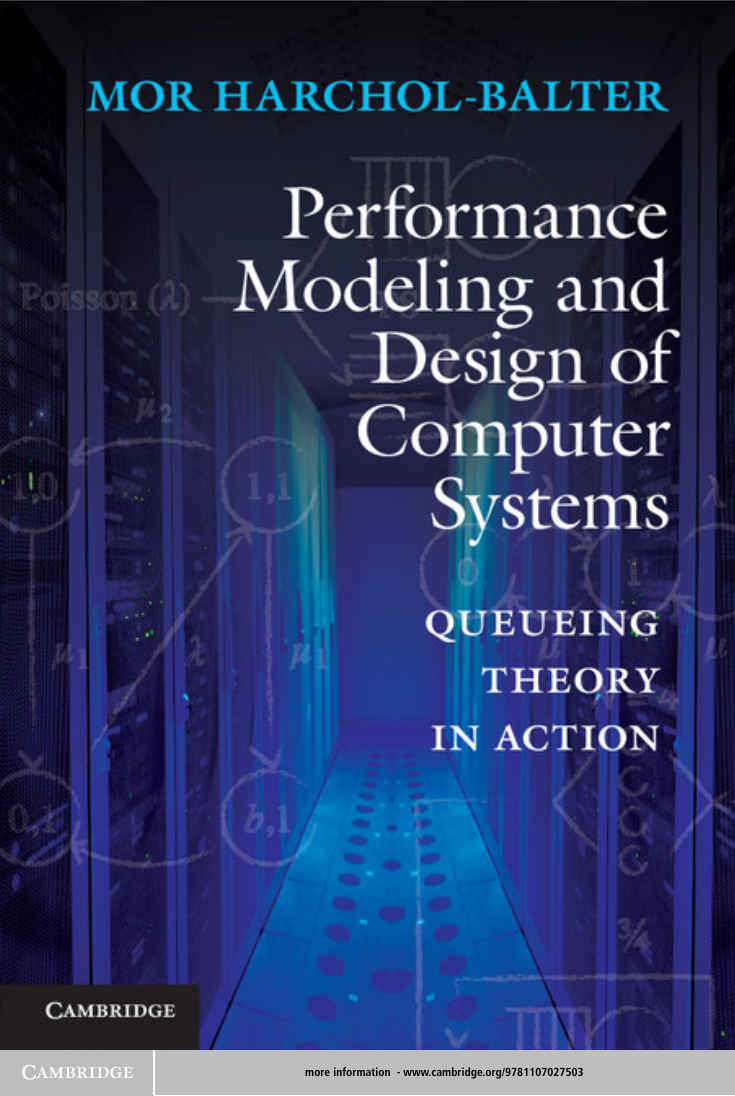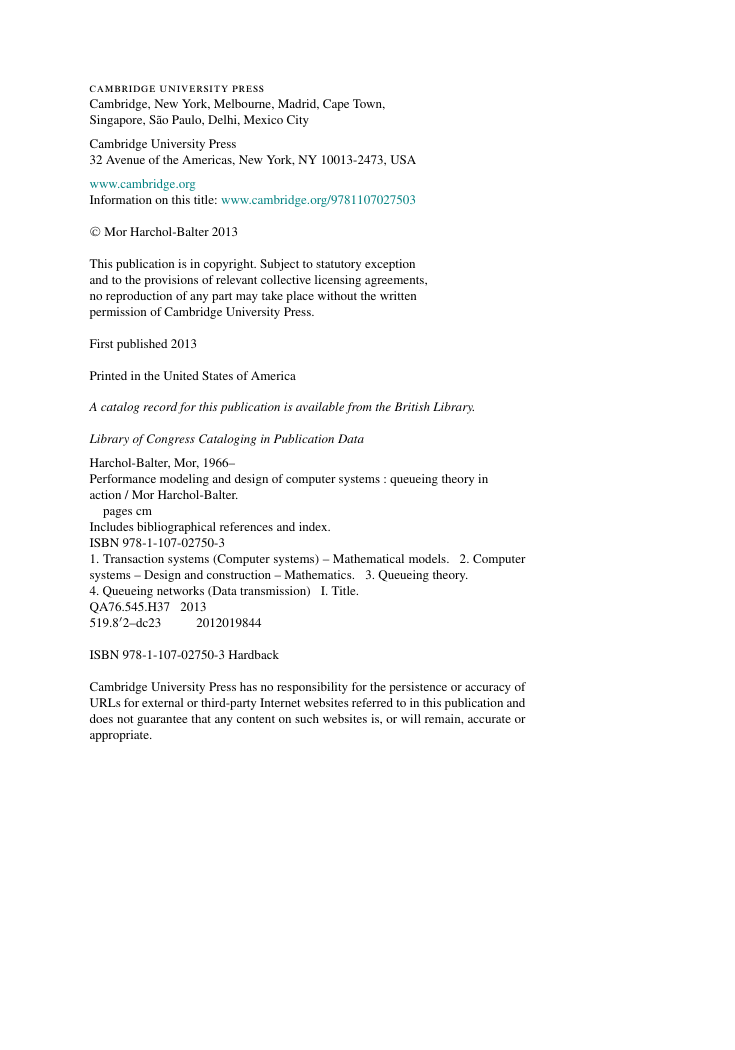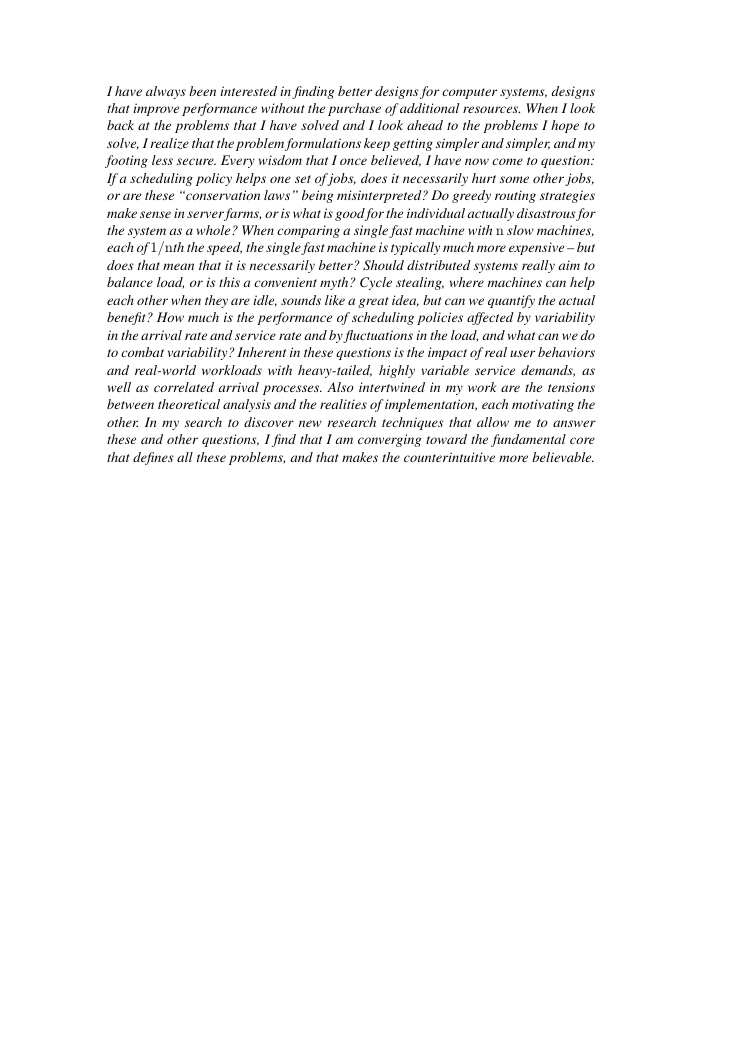Contents
Preface
The ad hoc World of Computer System Design
Analytical Modeling for Computer Systems
The Goal of This Book
How This Book Came to Be
Outline of the Book
Acknowledgments
Part I Introduction to Queueing
Chapter 1 Motivating Examples of the Power of Analytical Modeling
1.1 What Is Queueing Theory?
1.2 Examples of the Power of Queueing Theory
Chapter 2 Queueing Theory Terminology
2.1 Where We Are Heading
2.2 The Single-Server Network
2.3 Classification of Queueing Networks
2.4 Open Networks
2.5 More Metrics: Throughput and Utilization
2.6 Closed Networks
2.7 Differences between Closed and Open Networks
2.8 Related Readings
2.9 Exercises
Part II Necessary Probability Background
Chapter 3 Probability Review
3.1 Sample Space and Events
3.2 Probability Defined on Events
3.3 Conditional Probabilities on Events
3.4 Independent Events and Conditionally Independent Events
3.5 Law of Total Probability
3.6 Bayes Law
3.7 Discrete versus Continuous Random Variables
3.8 Probabilities and Densities
3.9 Expectation and Variance
3.10 Joint Probabilities and Independence
3.11 Conditional Probabilities and Expectations
3.12 Probabilities and Expectations via Conditioning
3.13 Linearity of Expectation
3.14 Normal Distribution
3.15 Sum of a Random Number of Random Variables
3.16 Exercises
Chapter 4 Generating Random Variables for Simulation
4.1 Inverse-Transform Method
4.2 Accept-Reject Method
4.3 Readings
4.4 Exercises
Chapter 5 Sample Paths, Convergence, and Averages
5.1 Convergence
5.2 Strong and Weak Laws of Large Numbers
5.3 Time Average versus Ensemble Average
5.4 Related Readings
5.5 Exercise
Part III The Predictive Power of Simple Operational Laws: ``What-If'' Questions and Answers
Chapter 6 Little's Law and Other Operational Laws
6.1 Little's Law for Open Systems
6.2 Intuitions
6.3 Little's Law for Closed Systems
6.4 Proof of Little's Law for Open Systems
6.5 Proof of Little's Law for Closed Systems
6.6 Generalized Little's Law
6.7 Examples Applying Little's Law
6.8 More Operational Laws: The Forced Flow Law
6.9 Combining Operational Laws
6.10 Device Demands
6.11 Readings and Further Topics Related to Little's Law
6.12 Exercises
Chapter 7 Modification Analysis: ``What-If'' for Closed Systems
7.1 Review
7.2 Asymptotic Bounds for Closed Systems
7.3 Modification Analysis for Closed Systems
7.4 More Modification Analysis Examples
7.5 Comparison of Closed and Open Networks
7.6 Readings
7.7 Exercises
Part IV From Markov Chainsto Simple Queues
Chapter 8 Discrete-Time Markov Chains
8.1 Discrete-Time versus Continuous-Time Markov Chains
8.2 Definition of a DTMC
8.3 Examples of Finite-State DTMCs
8.4 Powers of P: n-Step Transition Probabilities
8.5 Stationary Equations
8.6 The Stationary Distribution Equals the Limiting Distribution
8.7 Examples of Solving Stationary Equations
8.8 Infinite-State DTMCs
8.9 Infinite-State Stationarity Result
8.10 Solving Stationary Equations in Infinite-State DTMCs
8.11 Exercises
Chapter 9 Ergodicity Theory
9.1 Ergodicity Questions
9.2 Finite-State DTMCs
9.3 Infinite-State Markov Chains
9.4 Ergodic Theorem of Markov Chains
9.5 Time Averages
9.6 Limiting Probabilities Interpreted as Rates
9.7 Time-Reversibility Theorem
9.8 When Chains Are Periodic or Not Irreducible
9.9 Conclusion
9.10 Proof of Ergodic Theorem of Markov Chains
9.11 Exercises
Chapter 10 Real-World Examples: Google, Aloha, and Harder Chains
10.1 Google's PageRank Algorithm
10.2 Aloha Protocol Analysis
10.3 Generating Functions for Harder Markov Chains
10.4 Readings and Summary
10.5 Exercises
Chapter 11 Exponential Distribution and the Poisson Process
11.1 Definition of the Exponential Distribution
11.2 Memoryless Property of the Exponential
11.3 Relating Exponential to Geometric via -Steps
11.4 More Properties of the Exponential
11.5 The Celebrated Poisson Process
11.6 Merging Independent Poisson Processes
11.7 Poisson Splitting
11.8 Uniformity
11.9 Exercises
Chapter 12 Transition to Continuous-Time Markov Chains
12.1 Defining CTMCs
12.2 Solving CTMCs
12.3 Generalization and Interpretation
12.4 Exercises
Chapter 13 M/M/1 and PASTA
13.1 The M/M/1 Queue
13.2 Examples Using an M/M/1 Queue
13.3 PASTA
13.4 Further Reading
13.5 Exercises
Part V Server Farms and Networks: Multi-server, Multi-queue Systems
Chapter 14 Server Farms: M/M/k and M/M/k/k
14.1 Time-Reversibility for CTMCs
14.2 M/M/k/k Loss System
14.3 M/M/k
14.4 Comparison of Three Server Organizations
14.5 Readings
14.6 Exercises
Chapter 15 Capacity Provisioning for Server Farms
15.1 What Does Load Really Mean in an M/M/k?
15.2 The M/M/
15.3 Square-Root Staffing
15.4 Readings
15.5 Exercises
Chapter 16 Time-Reversibility and Burke's Theorem
16.1 More Examples of Finite-State CTMCs
16.2 The Reverse Chain
16.3 Burke's Theorem
16.4 An Alternative (Partial) Proof of Burke's Theorem
16.5 Application: Tandem Servers
16.6 General Acyclic Networks with Probabilistic Routing
16.7 Readings
16.8 Exercises
Chapter 17 Networks of Queues and Jackson Product Form
17.1 Jackson Network Definition
17.2 The Arrival Process into Each Server
17.3 Solving the Jackson Network
17.4 The Local Balance Approach
17.5 Readings
17.6 Exercises
Chapter 18 Classed Network of Queues
18.1 Overview
18.2 Motivation for Classed Networks
18.3 Notation and Modeling for Classed Jackson Networks
18.4 A Single-Server Classed Network
18.5 Product Form Theorems
18.6 Examples Using Classed Networks
18.7 Readings
18.8 Exercises
Chapter 19 Closed Networks of Queues
19.1 Motivation
19.2 Product Form Solution
19.3 Mean Value Analysis (MVA)
19.4 Readings
19.5 Exercises
Part VI Real-World Workloads: High Variability and Heavy Tails
Chapter 20 Tales of Tails: A Case Study of Real-World Workloads
20.1 Grad School Tales Process Migration
20.2 UNIX Process Lifetime Measurements
20.3 Properties of the Pareto Distribution
20.4 The Bounded Pareto Distribution
20.5 Heavy Tails
20.6 The Benefits of Active Process Migration
20.7 Pareto Distributions Are Everywhere
20.8 Exercises
Chapter 21 Phase-Type Distributions and Matrix-Analytic Methods
21.1 Representing General Distributions by Exponentials
21.2 Markov Chain Modeling of PH Workloads
21.3 The Matrix-Analytic Method
21.4 Analysis of Time-Varying Load
21.5 More Complex Chains
21.6 Readings and Further Remarks
21.7 Exercises
Chapter 22 Networks with Time-Sharing (PS) Servers (BCMP)
22.1 Review of Product Form Networks
22.2 BCMP Result
22.3 M/M/1/PS
22.4 M/Cox/1/PS
22.5 Tandem Network of M/G/1/PS Servers
22.6 Network of PS Servers with Probabilistic Routing
22.7 Readings
22.8 Exercises
Chapter 23 The M/G/1 Queue and the Inspection Paradox
23.1 The Inspection Paradox
23.2 The M/G/1 Queue and Its Analysis
23.3 Renewal-Reward Theory
23.4 Applying Renewal-Reward to Get Expected Excess
23.5 Back to the Inspection Paradox
23.6 Back to the M/G/1 Queue
23.7 Exercises
Chapter 24 Task Assignment Policies for Server Farms
24.1 Task Assignment for FCFS Server Farms
24.2 Task Assignment for PS Server Farms
24.3 Optimal Server Farm Design
24.4 Readings and Further Follow-up
24.5 Exercises
Chapter 25 Transform Analysis
25.1 Definitions of Transforms and Some Examples
25.2 Getting Moments from Transforms: Peeling the Onion
25.3 Linearity of Transforms
25.4 Conditioning
25.5 Distribution of Response Time in an M/M/1
25.6 Combining Laplace and z-Transforms
25.7 More Results on Transforms
25.8 Readings
25.9 Exercises
Chapter 26 M/G/1 Transform Analysis
26.1 The z-Transform of the Number in System
26.2 The Laplace Transform of Time in System
26.3 Readings
26.4 Exercises
Chapter 27 Power Optimization Application
27.1 The Power Optimization Problem
27.2 Busy Period Analysis of M/G/1
27.3 M/G/1 with Setup Cost
27.4 Comparing ON/IDLE versus ON/OFF
27.5 Readings
27.6 Exercises
Part VII Smart Schedulingin the M/G/1
Chapter 28 Performance Metrics
28.1 Traditional Metrics
28.2 Commonly Used Metrics for Single Queues
28.3 Today's Trendy Metrics
28.4 Starvation/Fairness Metrics
28.5 Deriving Performance Metrics
28.6 Readings
Chapter 29 Scheduling: Non-Preemptive, Non-Size-Based Policies
29.1 FCFS, LCFS, and RANDOM
29.2 Readings
29.3 Exercises
Chapter 30 Preemptive, Non-Size-Based Policies
30.1 Processor-Sharing (PS)
30.2 Preemptive-LCFS
30.3 FB Scheduling
30.4 Readings
30.5 Exercises
Chapter 31 Scheduling: Non-Preemptive, Size-Based Policies
31.1 Priority Queueing
31.2 Non-Preemptive Priority
31.3 Shortest-Job-First (SJF)
31.4 The Problem with Non-Preemptive Policies
31.5 Exercise
Chapter 32 Scheduling: Preemptive, Size-Based Policies
32.1 Motivation
32.2 Preemptive Priority Queueing
32.3 Preemptive-Shortest-Job-First (PSJF)
32.4 Transform Analysis of PSJF
32.5 Exercises
Chapter 33 Scheduling: SRPT and Fairness
33.1 Shortest-Remaining-Processing-Time (SRPT)
33.2 Precise Derivation of SRPT Waiting Time
33.3 Comparisons with Other Policies
33.4 Fairness of SRPT
33.5 Readings
Bibliography
Index
















 2023年江西萍乡中考道德与法治真题及答案.doc
2023年江西萍乡中考道德与法治真题及答案.doc 2012年重庆南川中考生物真题及答案.doc
2012年重庆南川中考生物真题及答案.doc 2013年江西师范大学地理学综合及文艺理论基础考研真题.doc
2013年江西师范大学地理学综合及文艺理论基础考研真题.doc 2020年四川甘孜小升初语文真题及答案I卷.doc
2020年四川甘孜小升初语文真题及答案I卷.doc 2020年注册岩土工程师专业基础考试真题及答案.doc
2020年注册岩土工程师专业基础考试真题及答案.doc 2023-2024学年福建省厦门市九年级上学期数学月考试题及答案.doc
2023-2024学年福建省厦门市九年级上学期数学月考试题及答案.doc 2021-2022学年辽宁省沈阳市大东区九年级上学期语文期末试题及答案.doc
2021-2022学年辽宁省沈阳市大东区九年级上学期语文期末试题及答案.doc 2022-2023学年北京东城区初三第一学期物理期末试卷及答案.doc
2022-2023学年北京东城区初三第一学期物理期末试卷及答案.doc 2018上半年江西教师资格初中地理学科知识与教学能力真题及答案.doc
2018上半年江西教师资格初中地理学科知识与教学能力真题及答案.doc 2012年河北国家公务员申论考试真题及答案-省级.doc
2012年河北国家公务员申论考试真题及答案-省级.doc 2020-2021学年江苏省扬州市江都区邵樊片九年级上学期数学第一次质量检测试题及答案.doc
2020-2021学年江苏省扬州市江都区邵樊片九年级上学期数学第一次质量检测试题及答案.doc 2022下半年黑龙江教师资格证中学综合素质真题及答案.doc
2022下半年黑龙江教师资格证中学综合素质真题及答案.doc